This easy Sauteed Butternut Squash is ready in under 20 minutes, and makes a great addition to any spread. With just three ingredients and a dash or salt, you can have a nutritious holiday squash dish that even the kids will love!
For more simple fall side dishes, check out my crispy garlic ginger kale and air fryer delicata fries.
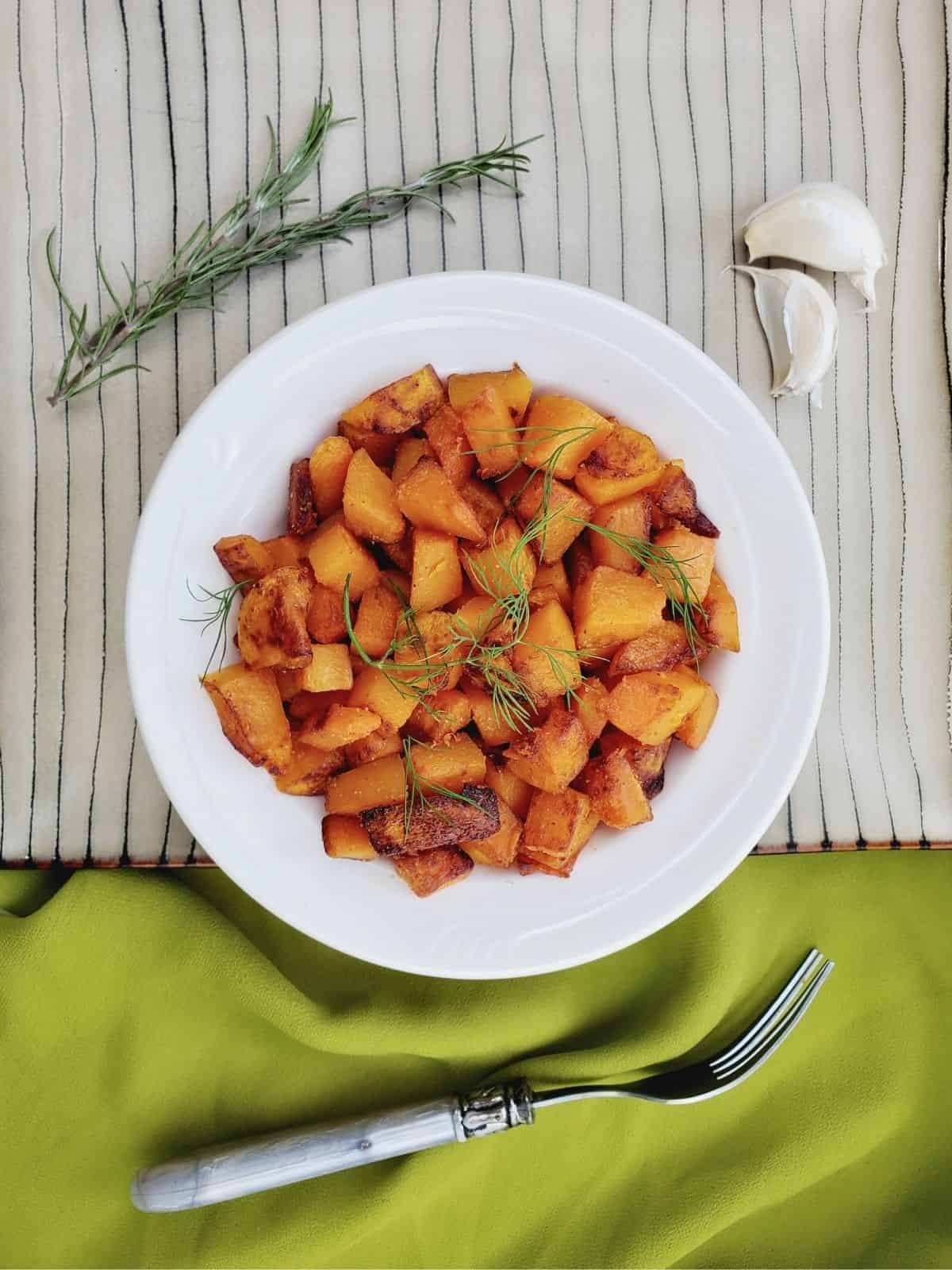
Jump to:
- 😋 What makes this recipe great
- 🌟 Ingredients
- ❓ How to Cut Butternut Squash for Roasting
- 📖 How to make sauteed butternut squash: step-by-step instructions
- 📝 Substitutions and Variations
- 😋 How to Use Leftover Butternut Squash
- ✔️ Freezing and Reheating
- 👨🏻🍳 Expert notes & tips
- ⭐ What to serve with sauteed squash
- 🙋🏻♂️ Frequently Asked Questions
- 🍴 Other Butternut Squash Recipes
- 📖 Recipe
- 💬 Comments
😋 What makes this recipe great
Use Up Extra Squash: a simple butternut squash sautee is my favorite way to use up extra scraps of squash after making squash fries or squash and apples, as you can easily adjust the ingredients to however much squash you need to cook up.
Great for Beginners: Luckily this recipe needs very few substitutions and even less babysitting, since butternut squash is quite forgiving of potential burning.
Low Histamine Holiday Dish: Whether you celebrate any holidays or not, this is a very fall-oriented dish, easy to make ahead of time, low histamine, and perfect for the whole family.
🌟 Ingredients

Butternut Squash: what's roasted apples and squash without the star of the show? This bright orange vegetable is a rich source of vitamins and minerals, and sweetens up beautifully in the oven. Much like my squash soup, this recipe takes advantage of that delicious oven-baked caramelization.
Oil: there are so many great fat sources for roasting butternut squash, and at this temp you can use almost any low histamine oil. My favorite for everyday use is coconut oil or avocado oil, though if you wanted a more robust flavor you could also use lard or butter.
Garlic Powder: this adds a lot of the savory flavor, though you could also use one clove of fresh minced garlic.
Salt: this adds contrast to the dish and lightly emphasizes the caramel sweetness of the sauteed squash.
❓ How to Cut Butternut Squash for Roasting
Butternut winter squash have a papery inedible skin and a relatively long harvest season, as in my area I start seeing them in the farmer's market in August. However they can be hard to cut, so it's helpful to microwave them for a couple of minutes before starting to peel them.
- The best way to prep a butternut squash for any cooking method is to start by washing and lightly scrubbing off any dirt. Since the skin is inedible, we need to peel it and we don't want the peeler pushing any dirt into the flesh.
- Then cut off the top and bottom, and cut the squash in half. Use a large spoon to scoop out the seeds and innards in the bottom portion. See directly below for images and more detailed step-by-step instructions.
- Next peel all the skin off the outsidecut each half in half, and then you can either cook the squash from there or slice the squash as desired, like the cubes needed in this apple butternut squash recipe.
📖 How to make sauteed butternut squash: step-by-step instructions
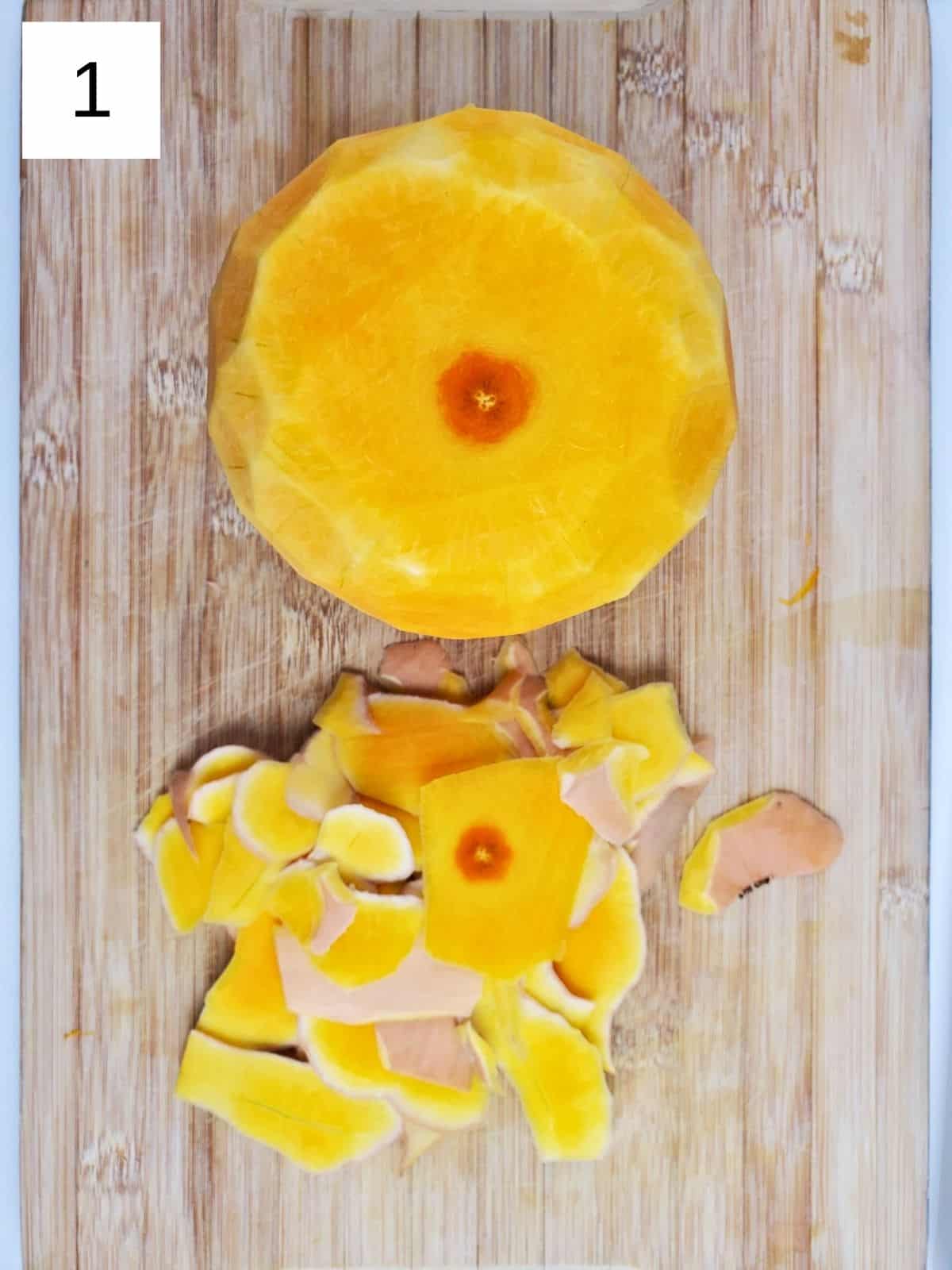


Step 1. Peel your squash (image 1) and cut it in half, then scoop out the seeds & squishy bits from the middle (image 2). Next cut it into ½" cubes, as uniform in size as possible or else they'll cook unevenly (image 3). If using pre-cut squash, just make sure your cubes are cut to ½" and pretty similar in size, otherwise the timing indicated in the recipe will need to be increased (for larger pieces of squash).

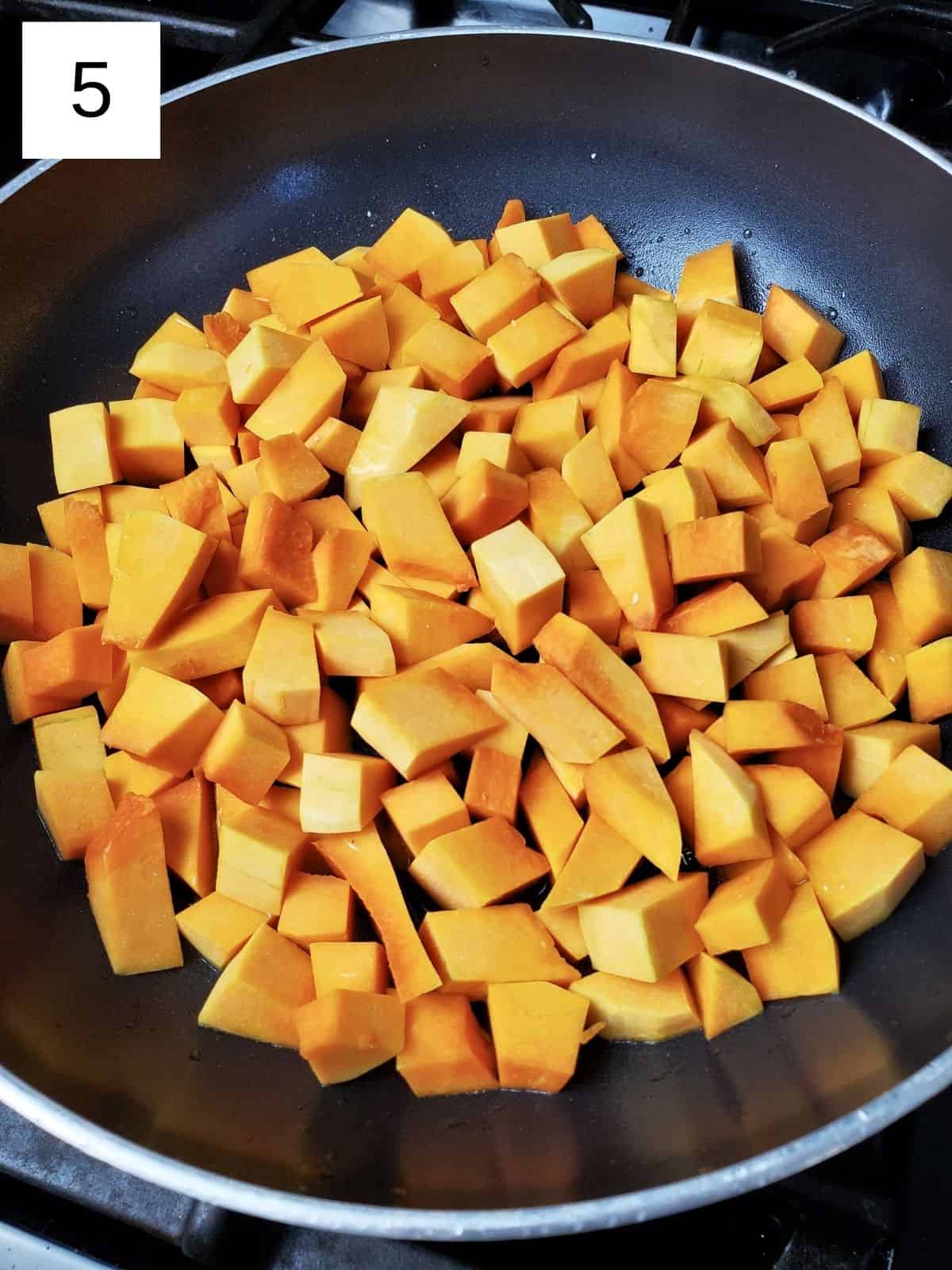
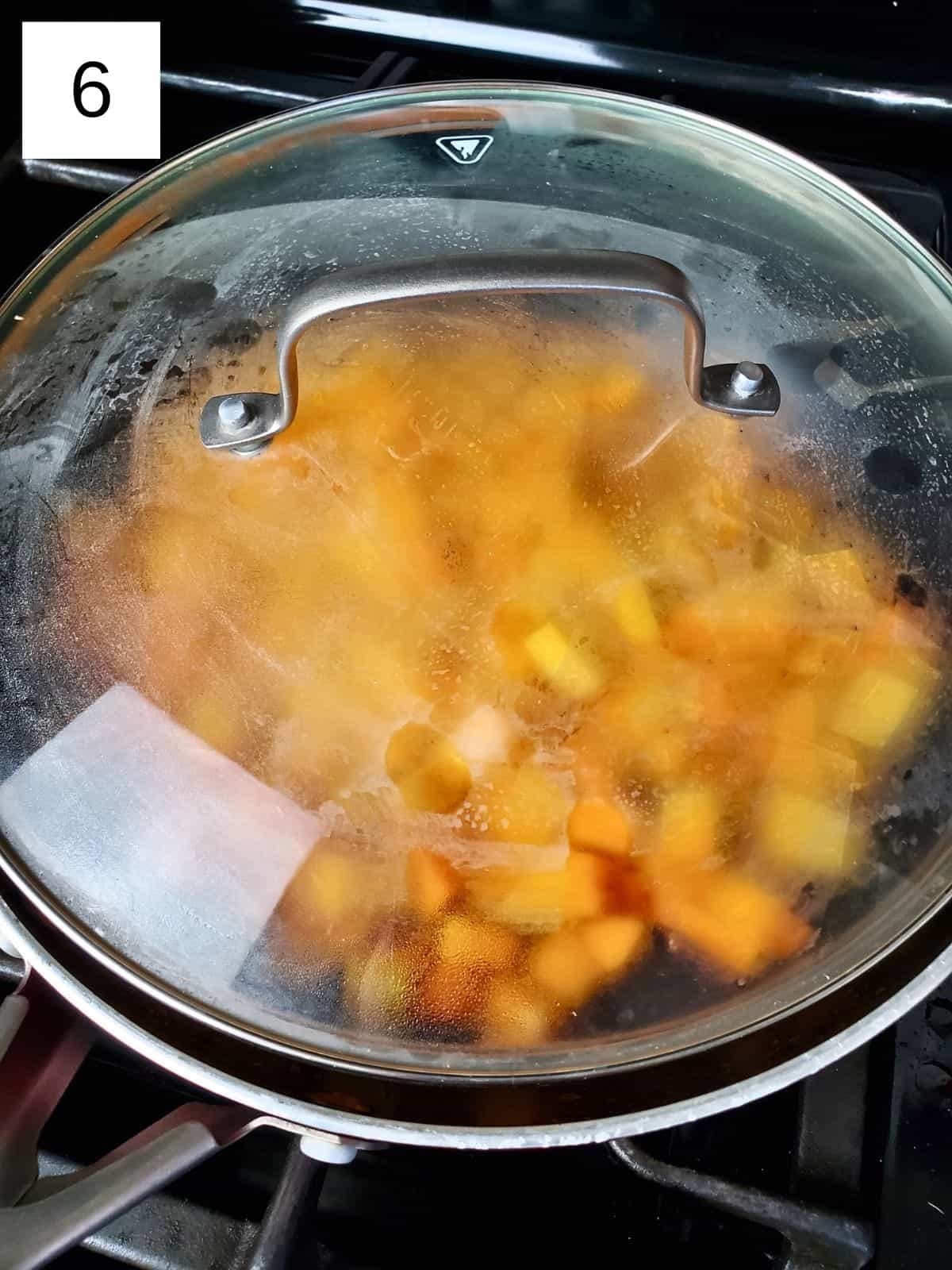
Step 2. Once done, drizzle your oil into a large lidded pan and turn on medium low heat (image 4), warming the oil for one minute before adding your squash cubes in a single layer (image 5) and putting on the lid (a little askew to let any steam escape). Raise the heat to medium and then cook for 6 minutes (image 6).
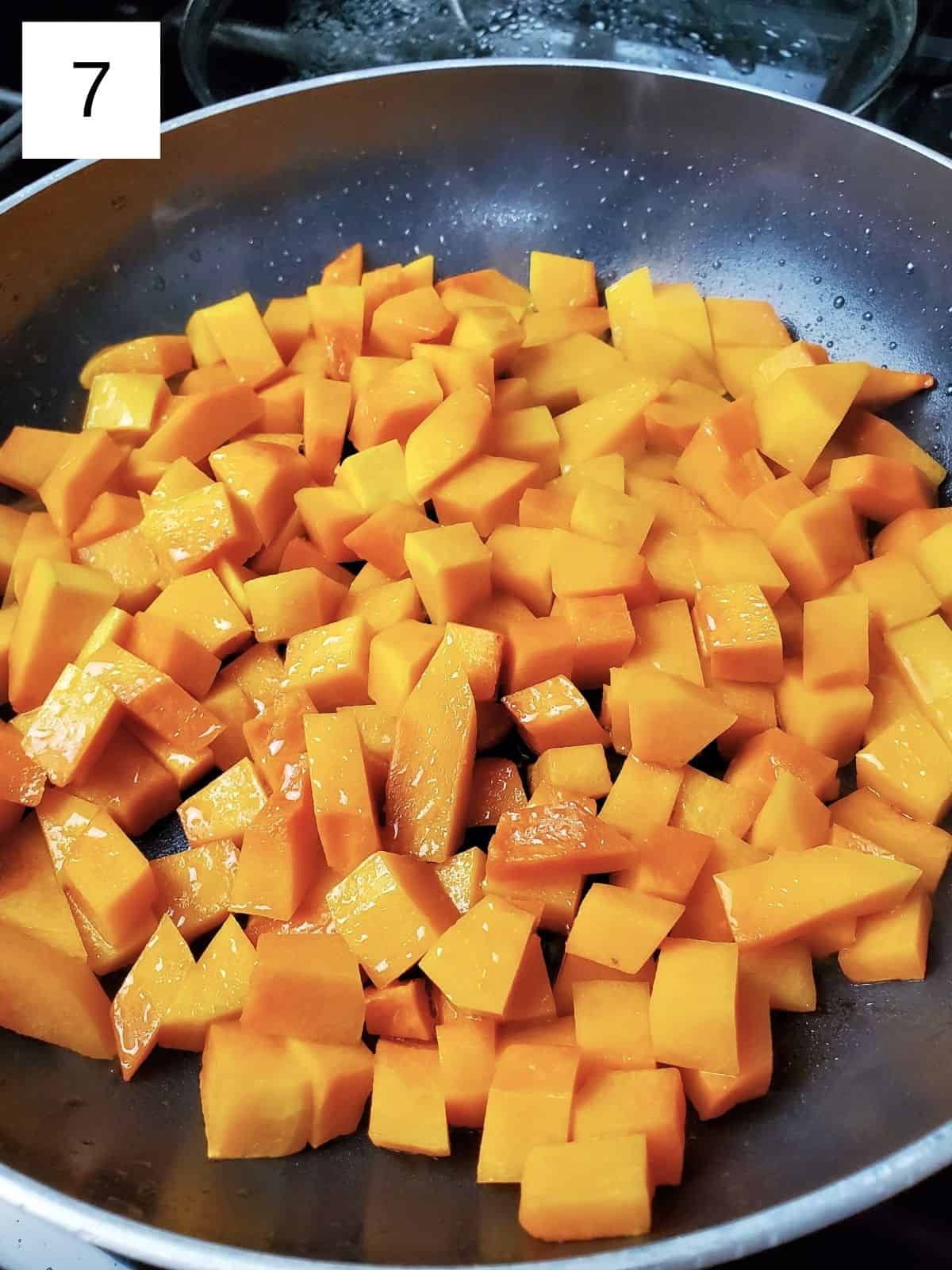
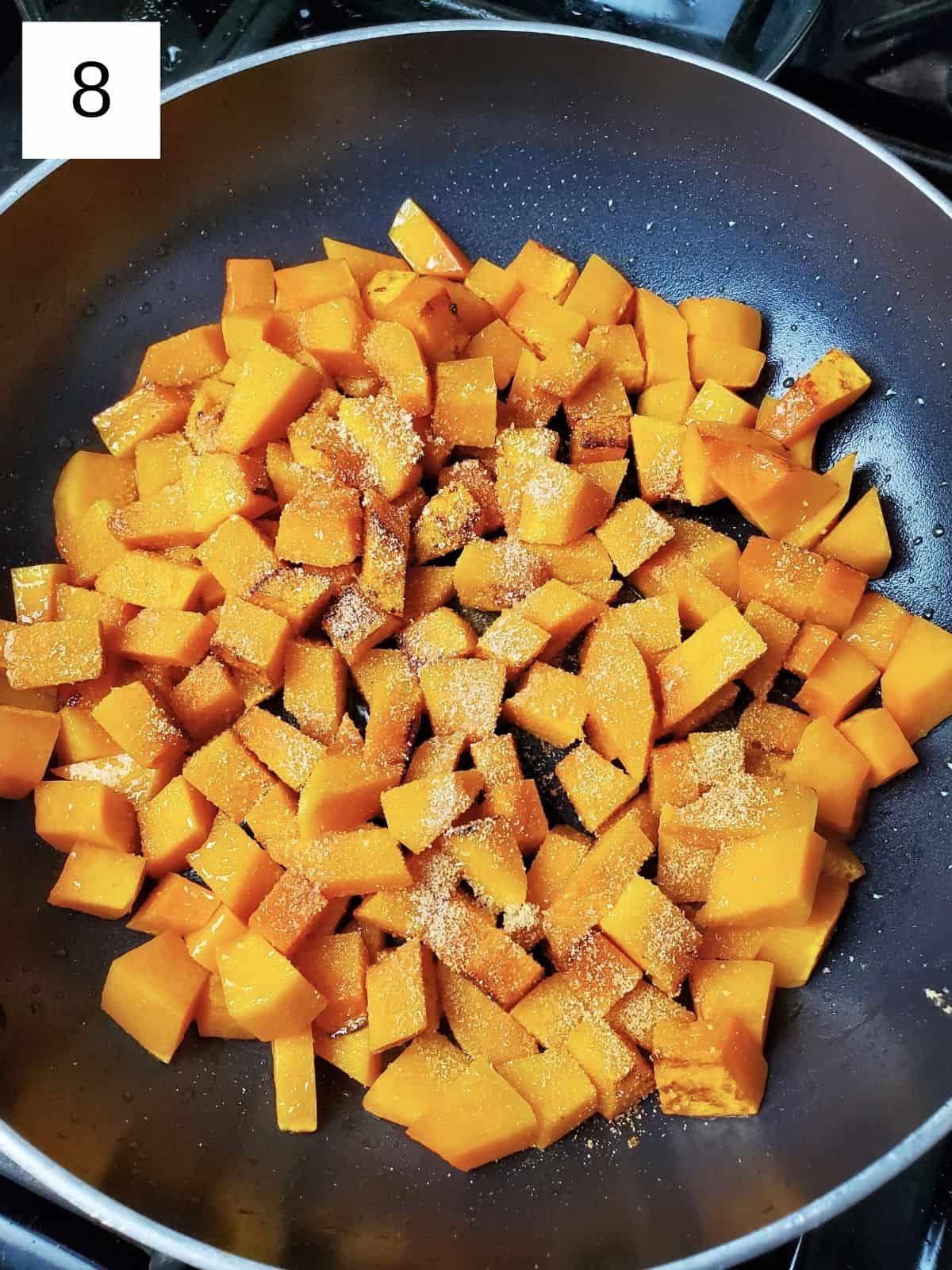
Step 3. Remove the lid and stir the squash (image 7), then lower the heat to medium-low, sprinkle on the garlic powder and salt (image 8), and stir thoroughly (image 9). Cook for 9-12 more minutes, stirring ocassionally to avoid burning. Your squash should be fork-tender and lightly browned, and then it's ready to enjoy (image 10).
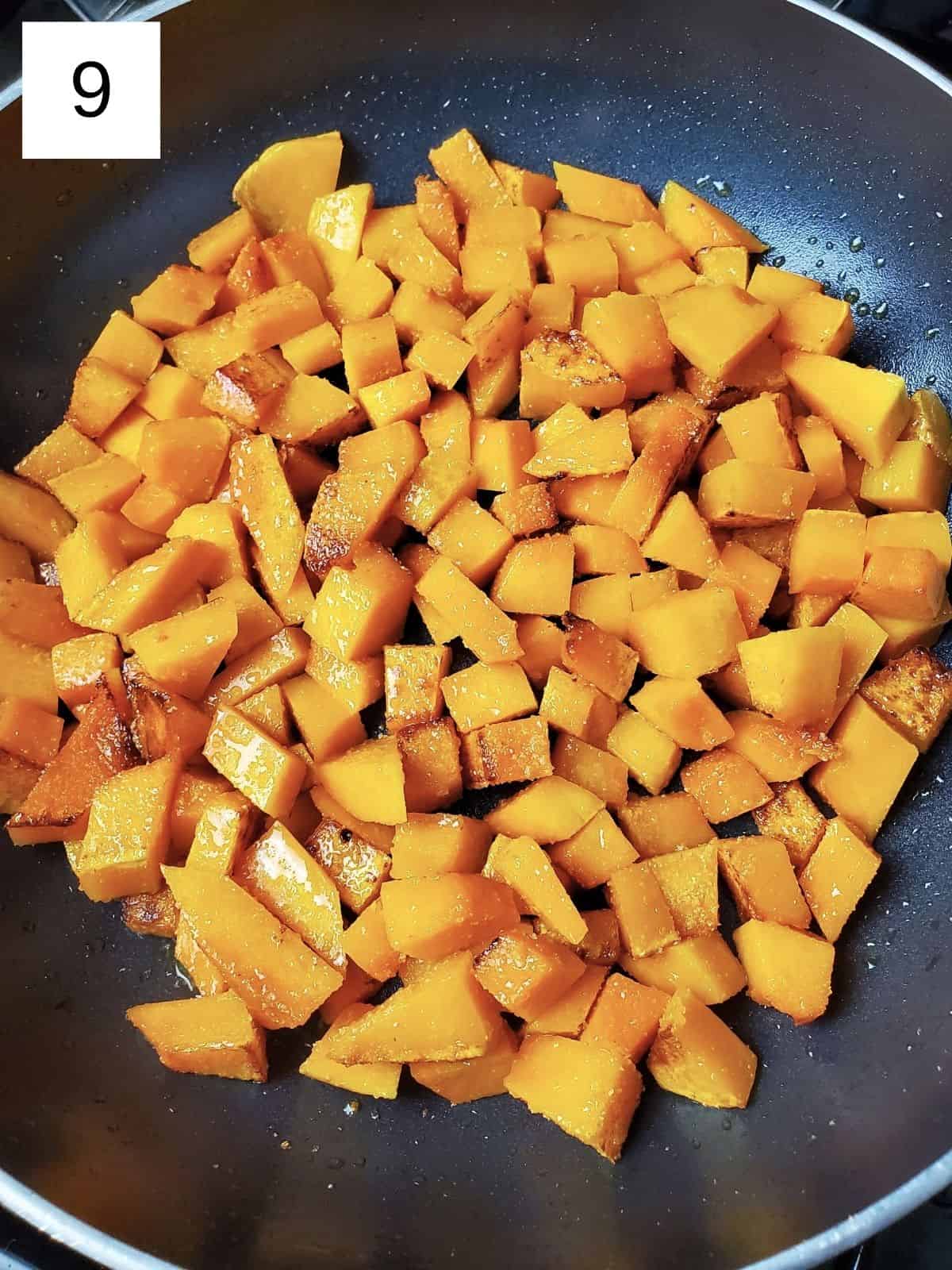

📝 Substitutions and Variations
Other Squash - other than butternut, you could also make this dish with any hardier winter squash, including kabocha and even honeynut squashes (the latter of which doesn't even need to be peeled).
Alternate Oils - since you need to roast butternut squash on the stovetop, you do need a high-heat friendly fat source, like coconut oil or even butter or ghee. Some good alternatives would be lard, avocado oil, or even olive oil for a savory verison.
Seasonings - If you know you don’t tolerate or like garlic, you can swap it for one or even a blend of other low histamine herbs and spices you think would go well. You can use anything, but other flavors and seasonings good on butternut squash include:
- fresh thyme with garlic
- use butter and add chopped sage
- cardamom and ginger for an Indian twist
Make it Sweet: for sweet sauteed butternut squash, swap the garlic powder for a teaspoon of maple syrup and a tablespoon of coconut sugar, and serve with a dollop of coconut cream or ice cream.
Make it Savory: for a savory sauteed butternut squash, I highly recommend using lard or tallow as the fat, and add in a ¼ teaspoon of ground black pepper and ½ teaspoon dried thyme or zata'ar (if tolerated). The savory version goes great with almost any pork dish, maybe with some brussels sprouts or broccoli on the side.
😋 How to Use Leftover Butternut Squash
- use it as part of the filling for a burrito
- use it to top your next salad
- put it into an omelette or frittata
- add it to your favorite curry
- mix it into a big bowl of pasta
- turn it into a bed for flavorful stewed lentils
- make vegan tacos by combining it with flavorful brussels sprouts
- blend it into a simple squash soup
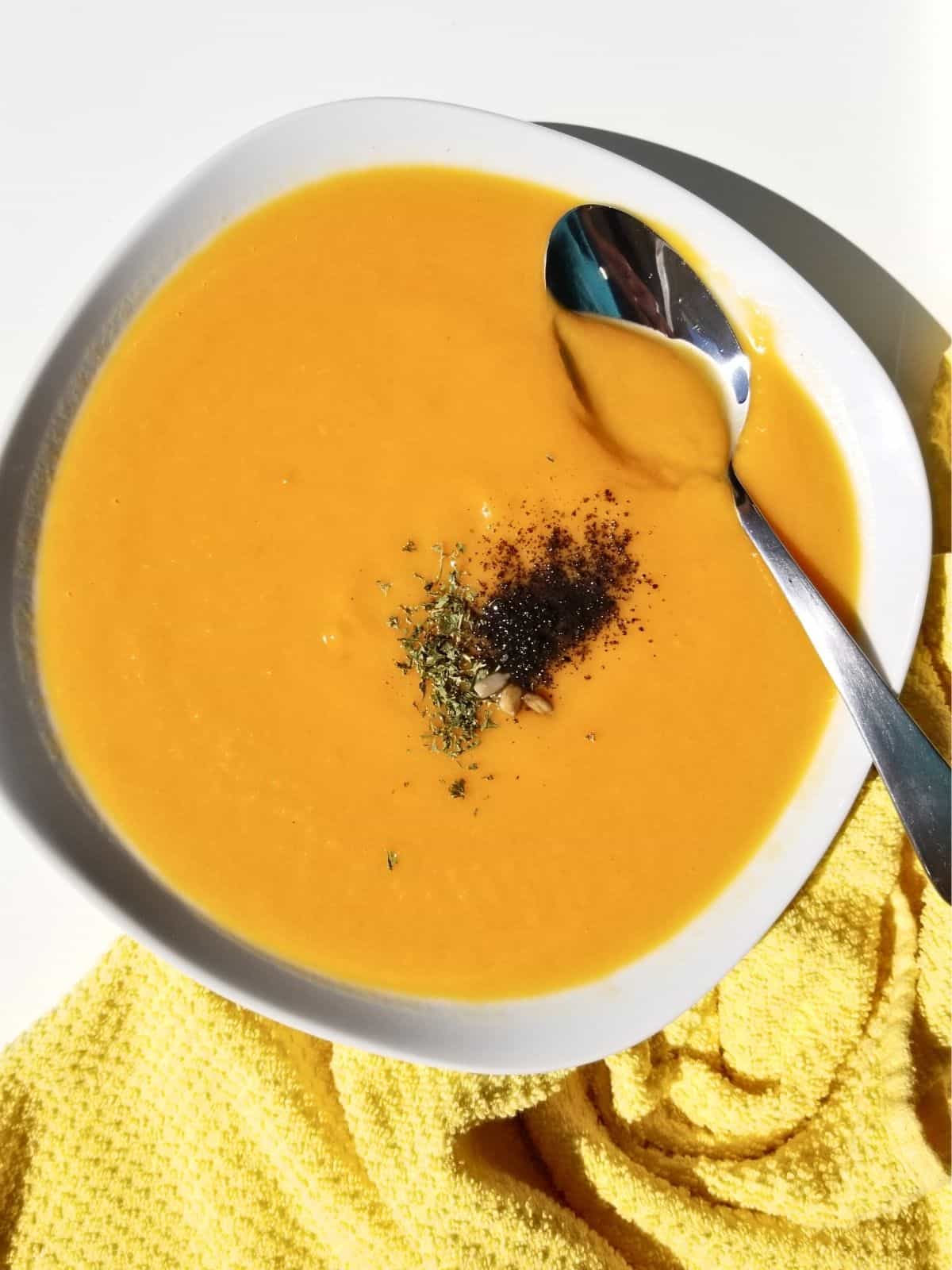
✔️ Freezing and Reheating
This dish freezes beautifully no matter whether you make it sweet or savory, so you can make a large batch, freeze it in single servings, and easily reheat on the stovetop on meidum-low (or microwave). Alternately, freeze everything in a big batch and reheat immediately before serving to a crowd.
Just note that if you do plan to freeze sauteed butternut squash, cook everything beforehand. Then let it cool to room temp and place it into a larger container for long-term storage.
To reheat the squash, heat it over medium-low on the stovetop for 7-10 minutes, then serve as desired.
👨🏻🍳 Expert notes & tips
Sweet Sauteed Squash: for a more sweet sauteed butternut squash, replace the garlic powder with 1 teaspoon of maple syrup, which will enhance the natural sugars in the squash and increase the amount of caramelization on the outside.
Reduce Moisture: I like to wipe the lid halfway through the initial cooking portion, to limit the amount of water dripping back into the pan and getting a nice roasted squash flavor throughout the dish.
Caramelized Squash: for that beautiful sear across the whole dish, make sure to leave your butternut squash sauteeing for a couple of minutes in between each occasional stir, otherwise you'll interrupt the browning process too much.
⭐ What to serve with sauteed squash
🙋🏻♂️ Frequently Asked Questions
No, like with most other winter squashes, butternut squash should be peeled before roasting, especially when making a more delicate dish, like this sauteed butternut squash recipe.
In this sauteed butternut squash recipe you can try honeynut, kabocha, or acorn squash, but each of them will bring their own unique flavor profiles to the final dish.
Sweet flavors to pair with butternut squash include cinnamon, vanilla, and cardamom, while the best savory flavors to pair with butternut squash include garlic, cumin, and thyme.
Yes, you can overcook squash and it can lose its firmness or even burn, so always keep an eye on it on the stovetop.
Generally bland squash is a result of underseasoning, sometimes just not adding enough salt, so if your squash tastes bland, start by adding a dash of salt, stirring well, and then tatsing it again. If that still doesn't help, add another ¼ to ⅓ the amount of called-for seasonings.
Roasted squash can get mushy either from overcooking or if the squash itself was overripe before being roasted.
Pork and chicken tend to be the best meats to serve with butternut squash, but any lighter meat will be good to complement the more delicate flavors in the sqash, including turkey or squab.
🍴 Other Butternut Squash Recipes
As always, if you like the recipe, I really appreciate a review or a 5-star comment!
📖 Recipe

Easy Sautéed Butternut Squash (in 20 Minutes)
Ingredients
- 1 medium butternut squash about 1 to 1 ½ pounds
- 1 ½ tablespoons neutral oil alt. ghee
- ½ teaspoon garlic powder
- ½ teaspoon sea salt
Instructions
- Peel your squash and cut it in half, then scoop out the seeds & squishy bits from the middle. Next cut it into ½" cubes, as uniform in size as possible or else they'll cook unevenly. If using pre-cut squash, just make sure your cubes are cut to ½" and pretty similar in size, otherwise the timing indicated in the recipe will need to be increased (for larger pieces of squash).
- Once done, drizzle your oil into a large lidded pan and turn on medium low heat, warming the oil for one minute before adding your squash cubes in a single layer and putting on the lid (a little askew to let any steam escape). Raise the heat to medium and then cook for 6 minutes.
- Remove the lid and stir the squash, then lower the heat to medium-low, sprinkle on the garlic powder and salt, and stir thoroughly. Cook for 9-12 more minutes, stirring ocassionally to avoid burning. Your squash should be fork-tender and lightly browned, and then it's ready to enjoy.

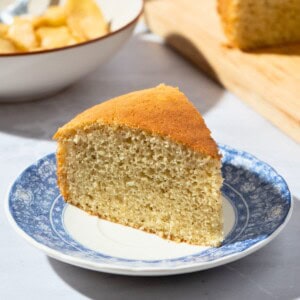











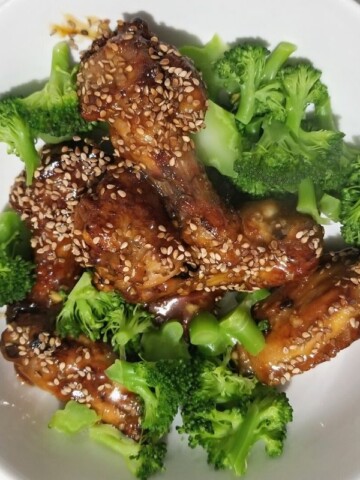
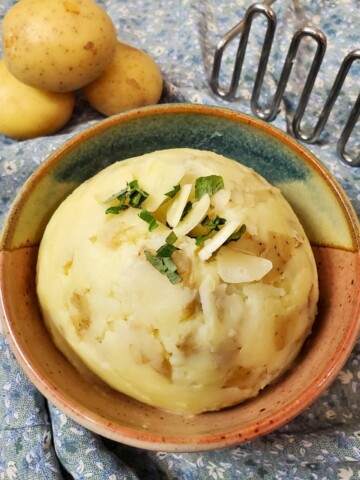
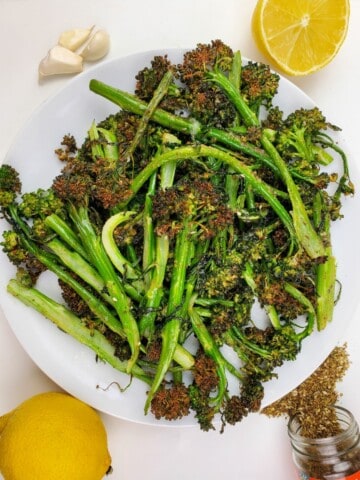

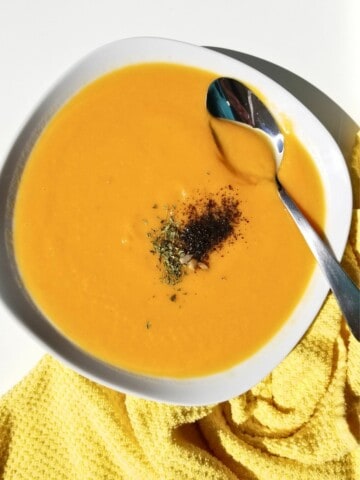
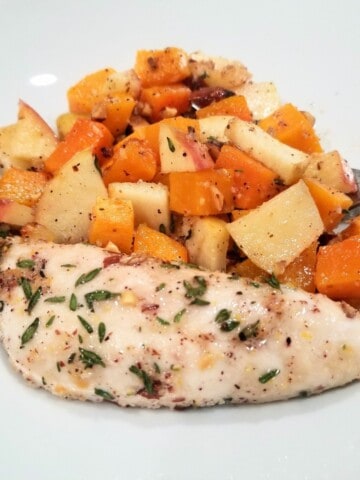
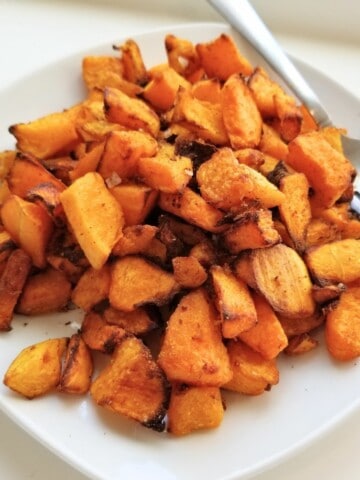
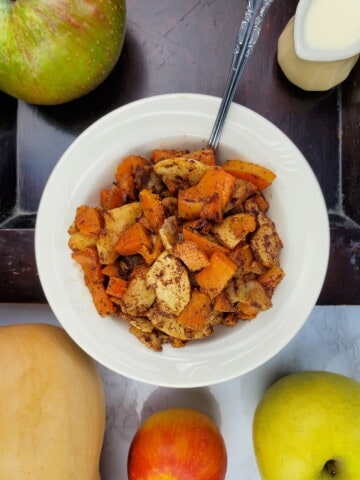
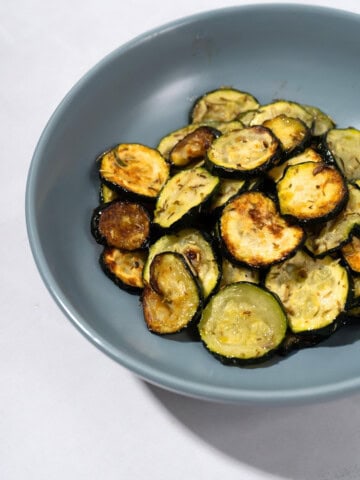

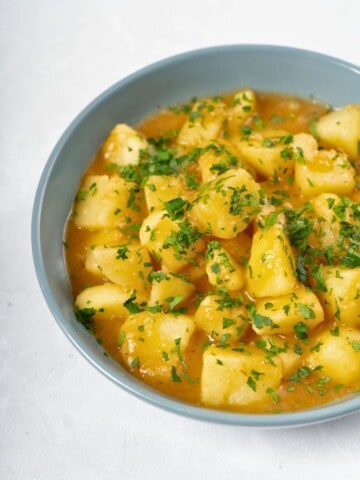
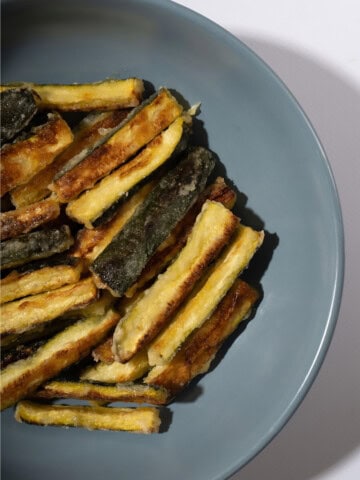
Comments
No Comments